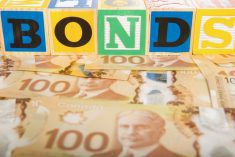The market is commonly a perplexing place, and one thing that has been perplexing me is why dividend stocks haven’t done better in an environment with ultra-low interest rates. Why would a company like BCE Inc. paying a safe 5.5 per cent dividend stagnate as interest rates decline, while a company like Shopify, paying no dividend, goes to the sky? Let me attempt to explain what might be happening, even though I may not fully agree with how the industry estimates company valuations.
The financial community values companies on what they believe is the current value of all future earnings or cash flows, using net present value (NPV) calculations. One website states, “The NPV formula: It’s important to understand exactly how the NPV formula works and the math behind it. NPV = F/[(1+r)^n] where PV = Present Value, F = Future payment (cash flow), r = Discount rate, n = the number of periods in the future.”
Read Also

Gentle treatments for pain in the neck
Heading toward year-end, people unknowingly tense up against the cold and busyness, causing neck pain that can often be treated with appropriate support and gentle mobility, athletic therapist Kathlyn Hossack says.
That’s a little more complex a formula than my brain can handle, but you can see an important component in the denominator is discount rate, otherwise known as interest rate. With the discount rate in the denominator, the lower it goes the higher the NPV goes. Low interest rates increase the current value of future earnings, while high interest rates reduce the current value of future earnings.
While the formula is complex, we can use the rule of 72 backwards to demonstrate. The normal use of the rule is to divide 72 by a rate of return to get the approximate number of years to double your money. If you achieve a six per cent annual return, you will double your money in about twelve years. Similarly, but this time calculating backwards, if you use a six per cent discount rate in the NPV formula, earnings derived twelve years from now are worth approximately half, presently. In other words, a dollar earned twelve years into the future is worth 50 cents today.
With interest rates at historically low levels, it makes sense that speculative and growth stocks trade at much higher valuations than value stocks, using the NPV formula. While there is no clear line of distinction, we can consider speculative stocks as those with negative cash flows, trading based on a concept and the expectation of future cash flow. Growth stocks are those with positive cash flow albeit small relative to their share price but are growing rapidly. Value stocks can be considered slower growing, mature companies with good current cash flow. It is value stocks that generally pay high dividends.
Speculative and growth companies are expected to earn gobs of money in the future, and those gobs of future money have a NPV much closer to the projected future earnings with a two per cent discount rate than a six per cent discount rate. Whether those earnings materialize or not seems academic in today’s environment. Using 36 years for an easy math time frame and the rule of 72 backwards, a dollar earned 36 years from now is worth 50 cents today with a two per cent discount rate. However, if the discount rate moves to a more normal six per cent, those future earnings halve in 12 years, and would be halved three times in the same 36 years. Therefore, a dollar earned 36 years from now would only be worth $1.00/2/2/2 = 12.5 cents.
If you struggled following the scenario, it’s probably because of my writing skills rather than your reading skills, so here’s the critical bottom line:
- At a six per cent interest rate, a dollar projected to be earned 36 years into the future contributes 12.5 cents to the value of the stock today.
- At a two per cent discount rate, that same dollar earned 36 years into the future contributes 50 cents to the value of the stock today. This drives much higher valuations for growth and speculative stocks in today’s low interest environment.
Given that value stocks are the ones paying higher dividends, this at least partly explains why high dividend stocks have not performed nearly as well as growth stocks in the current environment. It has nothing to do with the dividend itself, but rather the company growth rate. Dividends have very little effect on valuations and are an indication of a slow-growth company. Growth stocks will always be more expensive, but if we get a reversal of interest rates the gap should narrow and value stocks could have their day in the sun.
















